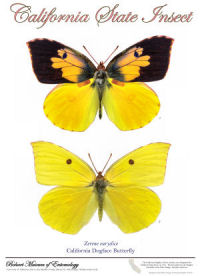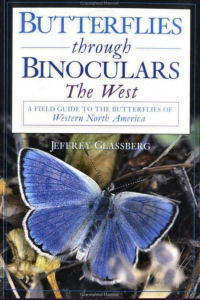California State Insect
| California dog-face butterfly |
Zerene eurydice |
Adopted:July 28, 1972 |
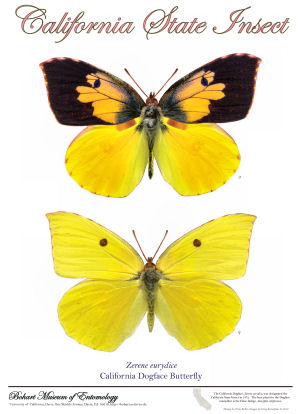 |
California dog-face butterfly: California State Insect
Top: Male, Bottom: Female
Poster from Bohart Museum of Entomology
Photograph: Greg Kareofelas, Design: Fran Keller |
Adoption of the California State Insect
In 1929, the Lorquin Entomological Society of Los Angeles conducted a statewide survey of active entomologists to select a butterfly that would best represent the State of California.
Winning the day, over such notables as Lorquin's admiral and the California sister butterflies, was the California dog-face butterfly. (At the time, the dog-face butterfly was also referred to as the California dog head butterfly and the flying pansy.)
The California Blue Book, published by the State Legislature in 1929, indicated that entomologists had selected the small, orange and yellow butterfly as the California insect.
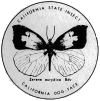 |
| Bureau of Entomology |
The Bureau of Entomology in the California Department of Agriculture used a representation of the California dog-face butterfly on its documents, labeling it the "California State Insect."
But no official action had occurred... until over 40 years later, when Mrs. Betty Harding and Mrs. Shirley Klein and their fourth-grade students at Daily Elementary School in Fresno took action and enlisted the help of State Assemblyman Kenneth L. Maddy.
Mr. Maddy introduced Assembly Bill No. 1843 (AB 1834) proposing that the California dog-face butterfly (Zerene Eurydice) be named the official State Insect. His bill was read for the first time on March 15, 1972 and referred to the Assembly Committee on Government Organization.
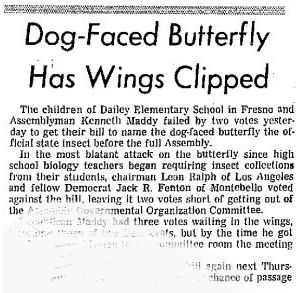 |
"Dog-Faced Butterfly Has Wings Clipped"
declared The Fresno Bee |
As the California dog-face butterfly had served for over forty years as California's state insect in an unofficial capacity, one would not have expected any objections to making it official. Surely the small butterfly had earned the honor?
On May 25, 1972, with a committee vote of 6-2, Mr. Maddy failed to garner the needed eight votes to recommend the legislation to a floor vote. It wasn't clear why two members voted against the bill, but a bill to designate an official state fossil also gone down to defeat earlier in the day.
The Fresno Bee wrote, "Dog-Faced Butterfly Has Wings Clipped."
Assemblyman Maddy vowed to fight on and promised a better result when the full committee was present in the next week.
Good to his word, Mr. Maddy moved the bill out of committee and to approval by the full Assembly on June 19. 1972.
A month later, on July 20, the Senate voted 29-0 to approve AB 1834.
On July 28, 1972, Governor Ronald Reagan signed Assembly Bill No. 1834 designating the California dog-face butterfly the official State Insect of California.
California Law
The following information was excerpted from the California Government Code, Title 1, Division 2, Chapter 2.
CALIFORNIA GOVERNMENT CODE
TITLE 1. GENERAL
DIVISION 2. STATE SEAL, FLAG, AND EMBLEMS
CHAPTER 2. STATE FLAG AND EMBLEMS
SECTION 420-429.8
424.5. The California dog-face butterfly (Zerene eurydice) is the
official State Insect.
Source: California State Legislature, California Law, , February 22, 2008.
Source: California State Assembly Chief Clerk, Legislative Document Archives, , April 8, 2008.
Source: Pacific Coast Entomological Society, April 9, 2008.
Source: The Pan-Pacific Entomologist, A state butterfly for California, J.D. Gunder, Vol. 6, No. 2 1929.
Source: The Lorquin Entomological Society, February 8, 2008.
Source: TheReporter, Bohart Museum Sparking Interest in State Insect: Rarely Seen in Nature, Rarely Recognized, , June, 2008.
Source: California State Assembly and Senate, Final History – 1972 Session, Assembly Final History – Regular Session
, Page 680.
Source: Statutes and Amendments to the Code – 1972, Volume I Regular Session, Chapters, Page 903.
Source: Simpson's Leader-Times, 43 Years, Tuesday, August 1, 1972, Page 4.
Source: The Fresno Bee, Dog-Faced Bufferfly Has Wings Clipped, Friday, May 26, 1972, Page 36.
Source: State Names, Seals, Flags and Symbols: A Historical Guide Third Edition, Revised and Expanded by Benjamin F. Shearer and Barbara S. Shearer. Greenwood Press; 3 Sub edition (October 30, 2001).
Additional Information
California Dogface, Zerene eurydice (Boisduval, 1855):
Species detail - Butterflies and Moths of North America.
Zerene eurydice:
Art Shapiro's Butterfly Site" Monitoring butterfly populations across Central California for more than 35 years…
California Dog-face butterfly:
Video providing information from Henry Shenkman and Natureways Productions.
California Dogface:
Photographs of Colias eurydice from "Natural History of Orange County," School of Biological Sciences, University of California, Irvine.
Bohart Museum of Entomology:
Web site of the Bohart Museum of Entomology at the University of California, Davis. The Bohart Museum, dedicated to teaching, research and service, houses the seventh largest insect collection in North Americas. The global collection of some seven million insects focuses on terrestrial and fresh water invertebrates. The museum is the home of the California Insect Survey, showcasing the insect biodiversity of the state’s deserts, mountains, coast and central valley.
Attract a California dog-face butterfly into your garden:
from the Las Pilitas nursery for native plants and native gardens.
Entomology:
The Natural History Museum of Los Angeles County.
The Pacific Coast Entomological Society:
The Pacific Coast Entomological Society is an organization devoted to western entomology in all its aspects..
Lorquin Entomological Society:
Web site of the Lorquin Entomological Society.
Butterflies through Binoculars: The West,
by Jeffrey Glassberg, 384 pages, Oxford University Press, USA (July 26, 2001) This field guide offers a comprehensive display of all the magnificent butterflies of the western region, stretching from the plains of middle America to the Pacific coast, and from southwestern Canada all the way to the Hawaiian islands. Jeffrey Glassberg's acclaimed Butterflies Through Binoculars series has essentially revolutionized the way we view butterflies. Featuring an extensive array of photographs, this new volume offers expert guidance in locating, identifying, and enjoying all the butterflies of the West.
Field Guide to Western Butterflies (Peterson Field Guides),
by Paul A. Opler, Amy Bartlett Wright (Illustrator), Roger Tory Peterson (Series Editor), 560 pages, Houghton Mifflin; 2 edition (April 15, 1999) More than 590 species, illustrated in lifelike positions on beautiful new color plates. With descriptions of all the butterflies that occur west of the 100th meridian in the United States and Canada, this guide has accurate information on ranges, habitats, flight seasons, food plants, and more.
|




